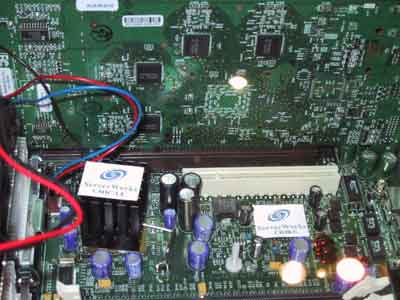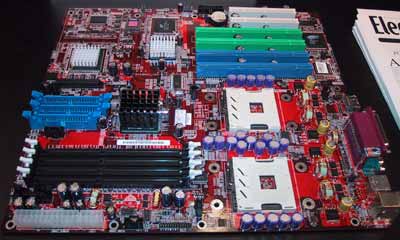Intel Developer Forum Spring 2002 - Day 4
by Anand Lal Shimpi on February 28, 2002 11:52 PM EST- Posted in
- Trade Shows
Making servers that work
With the release of the Intel E7500 chipset many have been saying that Intel will be stealing a great deal of market away from ServerWorks, the Broadcom company who has been manufacturing Intel's enterprise chipsets for the past several years; ServerWorks doesn't seem to agree. Not only is ServerWorks claiming higher performance out of their Grand Champion (GC) series of chipsets but they're claiming significantly higher performance with extremely high-end PCI-X I/O setups.

Peering into a GC-LE Workstation with a Quadro4
The ServerWorks GC-LE, for example, does have significantly more bandwidth to its PCI-X bridge and supports simultaneous bi-directional data transfers which could give it the edge over the E7500. The real question is under what circumstances does this bandwidth advantage matter? Without the ability to test a 120+ drive RAID array we can't pinpoint the exact circumstances in which the performance would vary by a noticeable amount but we're working with ServerWorks on performing some sort of a comparison between the two competing platforms in the future.

The GC-HE chipset offers support for up to 4 CPUs but in this case is used in
a 2-way server

The rest of ServerWorks' booth was pretty much the same as what we had seen at previous IDF conferences with the exception of the board pictured above based on the GC-SL chipset. The GC-SL will be aimed at the 2-way entry-level server market and thus is absent of some of the features that make the rest of the GC line so very attractive. The biggest limitation is the fact that it only features a 64-bit DDR memory bus instead of the dual and quad 64-bit DDR channels present in the GC-LE and GC-HE chipsets.
What lies in the future for ServerWorks? Right now it's obvious that these chipsets are composed of entirely too many individual chips, so going forward there will most likely be a focus on heavy integration of the functions of many of these independent chips (PCI-X bridges, Gigabit Ethernet controllers, etc...) into single pieces of Silicon. This will not only make the job of the motherboard manufacturer easier but it will also reduce the overall costs of the chipsets.










1 Comments
View All Comments
Dr AB - Monday, May 11, 2020 - link
Its 2020 and here we are, my laptop's display uses a copper wire and guess what got damaged because of the poorly built hinge mechanism. It's sad that even today that old crappy technology is still in use.